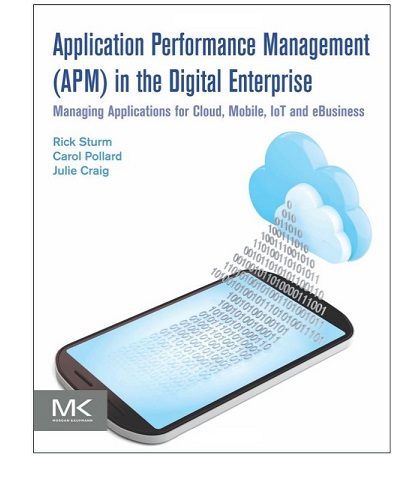The following is an edited excerpt from Application Performance Management (APM) in the Digital Enterprise: Managing Applications for Cloud, Mobile, IT, and eBusinessby Rick Sturm (CEO, Enterprise Management Associates), Carol Pollard and Julie Craig (Research Director for Applications, Enterprise Management Associates). The book is available now from Amazon.
This blog condenses some of the key concepts covered in Chapter 11, entitled Application Programming Interfaces and Connected Systems.
Start with APM in the API Economy - Part 1
API Management Tools
 So how and where do tools fit into this picture? Tools help rein in this growth and complexity by addressing key functional questions supporting tools acquisitions.
So how and where do tools fit into this picture? Tools help rein in this growth and complexity by addressing key functional questions supporting tools acquisitions.
API providers often find themselves asking:
■ How can we track usage growth and the impact of that growth on back-end systems for capacity planning purposes?
■ How do we ensure that only authorized users and applications connect to our systems?
■ How can our organization synchronize API development with traditional application development lifecycles since the two are often linked?
■ How can we secure API usage to ensure that sensitive data is protected?
■ How can we track usage of “for pay” services to correctly bill for access?
API consumers ask:
■ How do we find out about new APIs offered by our vendors and partners, and how do we then go about accessing them?
■ How do we know when the APIs our systems are accessing are modified by the provider?
■ We have hundreds of applications that access APIs—and some of them interact with one another. How do we measure end-to-end performance? And when one such application fails, how can we determine what changed, what's wrong, and how to fix it?
A large majority of both consumers and providers are monitoring performance and availability of applications accessing APIs from the perspective of the gateway. Although this is a good starting point, it is essentially a silo solution to a far broader and more complex problem.
API-connected applications, like any other tiered, distributed, or componentized applications, may have hundreds or thousands of potential failure points. From this perspective, simply monitoring the gateway is akin to monitoring server, network, or database silos. Such monitoring fails to address the touch points BETWEEN hardware and software elements that occur during application execution. In other words, it lacks the visibility to the entire end-to-end execution path that distinguishes application management from systems or silo management.
In the end, APM platforms — and API management systems -- should have mechanisms for incorporating gateway performance data into analytics, correlations, and dashboards. A few vendors are already addressing the API market with data-sharing capabilities and/or and products specifically designed to manage API-connected applications across each stage of the lifecycle. Lacking a single point of visibility and control to application execution (versus silo performance), full automation of the end-to-end monitoring/management function remains a fruitless quest.
EMA is currently in the process of launching new research into the automation and tools supporting the API Economy. This study, “Enterprise Management Strategies for the Connected Business: Hybrid Services and API Ecosystems Become Business as Usual”, will include both a user-facing survey and vendor “snapshots” encapsulating the types of tools and capabilities currently available in the enterprise management tools market.
The Latest
A vast majority (89%) of organizations have rapidly expanded their technology in the past few years and three quarters (76%) say it's brought with it increased "chaos" that they have to manage, according to Situation Report 2024: Managing Technology Chaos from Software AG ...
In 2024 the number one challenge facing IT teams is a lack of skilled workers, and many are turning to automation as an answer, according to IT Trends: 2024 Industry Report ...
Organizations are continuing to embrace multicloud environments and cloud-native architectures to enable rapid transformation and deliver secure innovation. However, despite the speed, scale, and agility enabled by these modern cloud ecosystems, organizations are struggling to manage the explosion of data they create, according to The state of observability 2024: Overcoming complexity through AI-driven analytics and automation strategies, a report from Dynatrace ...
Organizations recognize the value of observability, but only 10% of them are actually practicing full observability of their applications and infrastructure. This is among the key findings from the recently completed Logz.io 2024 Observability Pulse Survey and Report ...
Businesses must adopt a comprehensive Internet Performance Monitoring (IPM) strategy, says Enterprise Management Associates (EMA), a leading IT analyst research firm. This strategy is crucial to bridge the significant observability gap within today's complex IT infrastructures. The recommendation is particularly timely, given that 99% of enterprises are expanding their use of the Internet as a primary connectivity conduit while facing challenges due to the inefficiency of multiple, disjointed monitoring tools, according to Modern Enterprises Must Boost Observability with Internet Performance Monitoring, a new report from EMA and Catchpoint ...
Choosing the right approach is critical with cloud monitoring in hybrid environments. Otherwise, you may drive up costs with features you don’t need and risk diminishing the visibility of your on-premises IT ...
Consumers ranked the marketing strategies and missteps that most significantly impact brand trust, which 73% say is their biggest motivator to share first-party data, according to The Rules of the Marketing Game, a 2023 report from Pantheon ...
Digital experience monitoring is the practice of monitoring and analyzing the complete digital user journey of your applications, websites, APIs, and other digital services. It involves tracking the performance of your web application from the perspective of the end user, providing detailed insights on user experience, app performance, and customer satisfaction ...
Enterprises are experiencing a 13% year-over-year increase in customer-facing incidents, reflecting rising levels of complexity and risk as businesses drive operational transformation at scale, according to the 2024 State of Digital Operations study from PagerDuty ...





